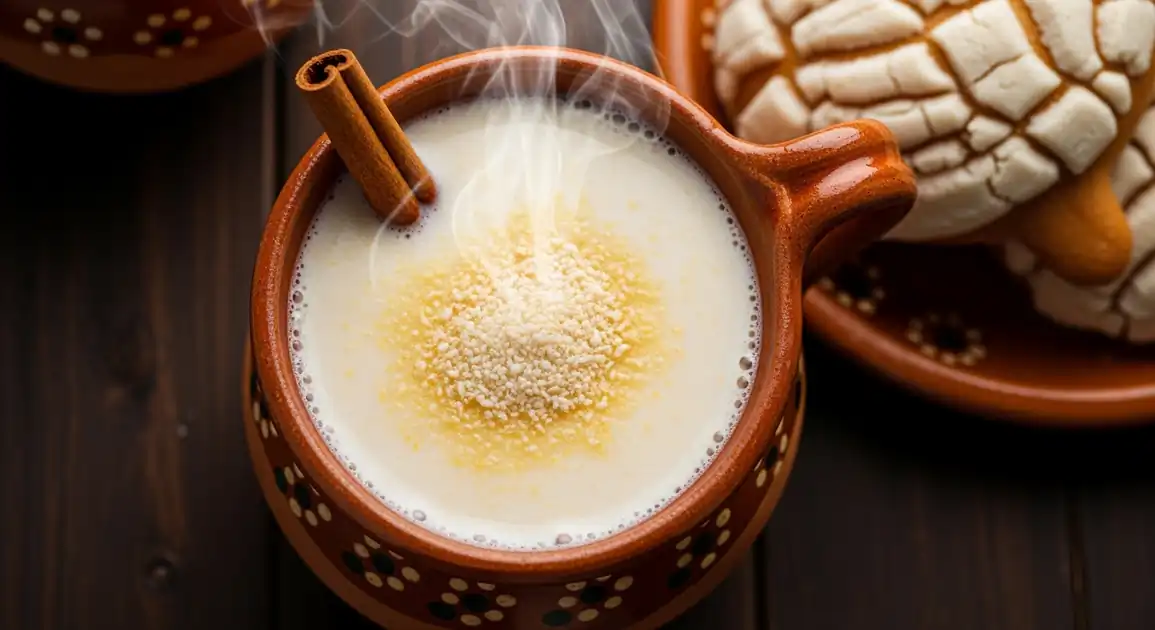Atole de Granillo
Atole de Granillo

Description
In Oaxaca, Atole de Granillo holds special cultural significance, with recipes passed down through generations. This region, known for preserving indigenous culinary traditions, maintains some of the most authentic preparation methods. Oaxacan atole often features locally grown corn varieties and traditional clay pot preparation, creating distinctive regional character and deeper connection to pre-Hispanic roots.
Dietary Information
Serving information
Serving style
In Oaxaca, traditionally served in handcrafted clay cups or colorful ceramic mugs. Often paired with regional specialties like tamales oaxaqueños wrapped in banana leaves or pan de yema (egg bread).
Quick facts
Market vendors: 6 AM - 11 AM and sometimes 4 PM - 7 PM. During festivals: extended hours until 10 PM or later.
Safety Tips
What to Look For
-
Steaming hot atole served from a constantly heated pot
Proper temperature (near boiling) ensures safety by eliminating pathogens. The atole should be visibly steaming when served.
-
Frequent stirring by the vendor
Continuous stirring prevents burning and ensures even cooking and temperature distribution, increasing both safety and quality.
-
Clean ladles and serving containers
Serving utensils and cups should appear clean and well-maintained to prevent contamination.
-
Covered pots when not actively serving
Covers protect the atole from airborne contaminants and help maintain proper temperature.
-
Visible corn grits in suspension
Properly prepared atole de granillo will have small corn particles distributed throughout, not settled at the bottom, indicating proper preparation and frequent stirring.
What to avoid
-
Lukewarm or room temperature atole
Atole should always be served hot. Tepid temperature could indicate it's been sitting too long and may harbor bacteria.
-
Excessive settling/separation in the pot
If corn particles have completely settled to the bottom, the atole may have been sitting too long without stirring.
-
Burned odor or taste
A scorched smell indicates improper cooking technique and could mask other quality issues.
-
Sour or fermented smell
Fresh atole has a sweet corn aroma. Any sour notes could indicate spoilage, especially in milk-based versions.
-
Vendors with visibly poor hygiene practices
Observe general cleanliness of the preparation area, handling practices, and the vendor's attention to basic hygiene.
Price information
Price range
Budget tips
- Indigenous market vendors offer the most authentic and affordable options (15-25 MXN).
- Neighborhood vendors announced by distinctive calls or whistles serve homestyle versions at good prices (20-30 MXN).
- Central tourist areas charge more (35-60 MXN) but may offer bilingual service.
- For best value, venture into residential neighborhoods or local mercados.
Value indicators
- Texture with evenly distributed corn particles.
- Preparation in traditional clay pots (ollas de barro).
- Complex flavor from properly toasted corn.
- Handmade clay or ceramic serving cups.
- Use of local piloncillo for sweetening.
Where to Find This Dish
Mercado 20 de Noviembre
Famous food market with multiple vendors selling traditional beverages in the prepared foods section.
20 de Noviembre Market, Near the grilled meat hall
Morning (7 AM - 11 AM), Afternoon (4 PM - 6 PM)
Mercado Benito Juárez
Central market with established food stalls serving atole and other traditional beverages.
Benito Juárez Market, Near the central fountain
Morning (6 AM - 10 AM)
Centro Histórico
During festivities, numerous temporary stands appear in and around the Zócalo (main square).
Zócalo, Santo Domingo Church, Andador Turístico
Early Morning, Evening (during festivals)
Etla Valley Communities
Known for preserving traditional atole preparation methods in surrounding indigenous communities.
Weekly markets, Community centers
Market days (varies by community)
Vendor Tips
- In Oaxaca, look for atole prepared in traditional clay pots (ollas de barro) for the most authentic flavor.
- Some vendors specialize in atole during specific seasons - ask locals for recommendations based on current festivals.
- The best vendors typically grind their own corn rather than using commercial products.
- For a truly traditional experience, seek out indigenous vendors who often maintain pre-Hispanic preparation methods.
How to Order
Regional Variations
-
Atole de Granillo Con Chilacayote
(Atole de Granillo Con Chilacayote)
A special Oaxacan variation that includes pieces of candied squash (chilacayote) as a sweet addition to the drink.
-
Atole de Granillo Negro
(Atole de Granillo Negro)
Made with blue or black corn varieties native to Oaxaca, resulting in a distinctive color and slightly nuttier flavor profile.
-
Tejate
(Tejate)
While technically distinct from atole, tejate is another important Oaxacan corn-based beverage, served cold with cacao and mamey seeds, sometimes made by the same vendors who prepare atole.
Cultural context
History
Atole traces back to pre-Hispanic Mesoamerica, where corn-based drinks were staples of Aztec and Mayan civilizations. The word 'atole' derives from the Nahuatl 'atolli,' meaning 'watery corn gruel.' While refined atoles became popular during colonial times, Atole de Granillo maintains closer ties to indigenous preparations by preserving the textural essence of corn. In Oaxaca, it remains particularly significant, being integral to celebrations like Día de Muertos and various religious festivities, where it represents cultural continuity across centuries.
Local significance
In Oaxaca, atole transcends being merely a beverage - it represents cultural continuity from pre-Hispanic times and is integral to the region's identity as a guardian of indigenous culinary traditions.
Eating customs
- In Oaxaca, atole is often consumed alongside regional tamales, particularly tamales de mole negro, tamales de amarillo, or sweet tamales de piña.
- During indigenous ceremonies, atole may be consumed with specific ritual significance.
- The texture of atole de granillo is particularly celebrated in Oaxaca, where the graininess is considered a mark of quality.
- Often served in special decorative cups during celebrations.